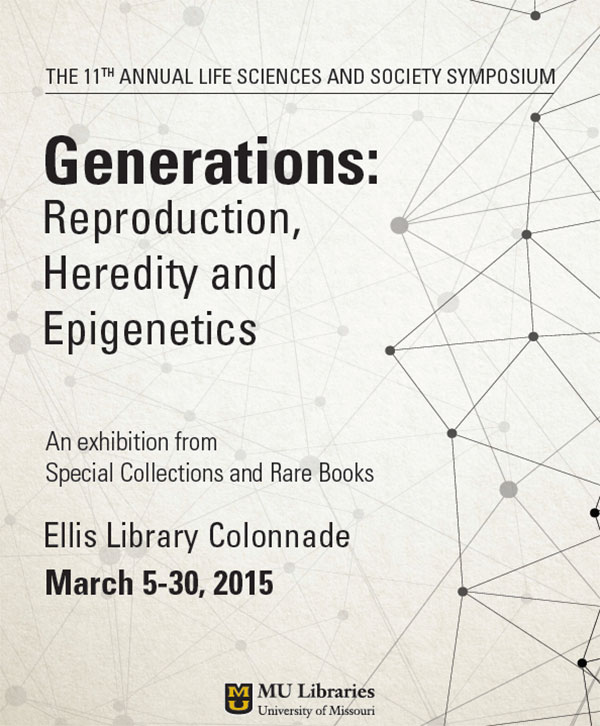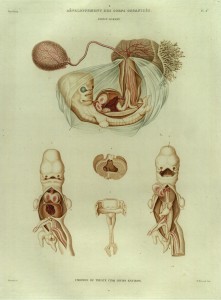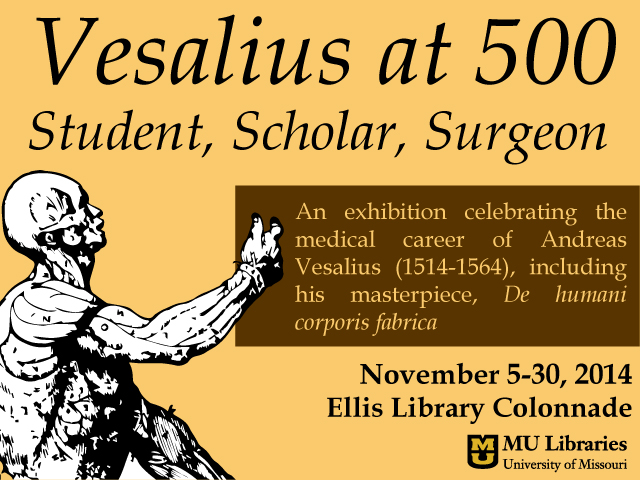Celebrating the Contributions of African American Scientists at NIH

Your source for what's new at Mizzou Libraries


What do old books have to do with cutting-edge science? More than you might think.
 This year, the annual Life Sciences and Society Symposium is considering a relatively new scientific field: epigenetics. "Epigenetics refers to the study of traits that are heritable but not caused by changes in the DNA sequence," writes Dr. Karthik Panchanathan, an assistant professor in the department of anthropology at the University of Missouri. "In some cases, events that happen during an individual’s life can sometimes result in epigenetic changes that are subsequently heritable. This is a form of Lamarckian inheritance, the idea that an organism can pass on characteristics that it acquired during its lifetime to its offspring."
This year, the annual Life Sciences and Society Symposium is considering a relatively new scientific field: epigenetics. "Epigenetics refers to the study of traits that are heritable but not caused by changes in the DNA sequence," writes Dr. Karthik Panchanathan, an assistant professor in the department of anthropology at the University of Missouri. "In some cases, events that happen during an individual’s life can sometimes result in epigenetic changes that are subsequently heritable. This is a form of Lamarckian inheritance, the idea that an organism can pass on characteristics that it acquired during its lifetime to its offspring."
This year's Life Sciences and Society Symposium considers the implications of epigenetics for human health and behavior. Speakers will discuss what epigenetics means, how the environment affects genetic expression, and how the fast-changing field of epigenetics is transforming medicine and society. See a lineup of speakers and register for the symposium on the Life Sciences and Society program website.
Special Collections is participating in the symposium with an exhibition of rare books and an opening lecture to kick off the symposium week. Although the scientific study of epigenetics dates only to the middle of the twentieth century, scientists have puzzled over related questions of heredity and development for hundreds of years. Does it matter whether you inherit a trait from your mother or father? How do your earliest stages of development influence the rest of your life? Which characteristics are inborn, and which are learned? These are questions being asked by epigenetics researchers today, and they are the questions we consider in a historical sense in the exhibition, through an in-depth look at topics such as early theories of generation, maternal imagination, child development, and original sin.
 Dr. Panchanathan will open the exhibit with a lecture entitled "Genes, Culture and Evolution." Humans are unique among animals in the degree to which adaptive behavior is shaped by both genes and culture. Cultural transmission is a form of Lamarckian inheritance: individuals pass on cultural traits which they learned during their lifetime to their offspring. In this talk, Dr. Panchanathan will discuss how anthropologists think about and model cultural evolution. In particular, Dr. Panchanathan will discuss how and why natural selection on genes resulted in the human capacity for culture; how cultural evolution is similar to and different from genetic evolution; and how cultural processes have shaped our genes, so-called gene-culture co-evolution.
Dr. Panchanathan will open the exhibit with a lecture entitled "Genes, Culture and Evolution." Humans are unique among animals in the degree to which adaptive behavior is shaped by both genes and culture. Cultural transmission is a form of Lamarckian inheritance: individuals pass on cultural traits which they learned during their lifetime to their offspring. In this talk, Dr. Panchanathan will discuss how anthropologists think about and model cultural evolution. In particular, Dr. Panchanathan will discuss how and why natural selection on genes resulted in the human capacity for culture; how cultural evolution is similar to and different from genetic evolution; and how cultural processes have shaped our genes, so-called gene-culture co-evolution.
Dr. Panchanathan's presentation is on Monday, March 9, at 1:00 PM in the Government Documents area in Ellis Library. Generations: Reproduction, Heredity, and Epigenetics will be on display in the Ellis Library Colonnade March 5-30, 2015.

December 31, 2014, will mark the five hundredth birthday of Andreas Vesalius, one of the most important anatomists in the history of medicine. The MU Libraries will commemorate this historic occasion with an exhibition entitled Vesalius at 500: Student, Scholar, and Surgeon, on view November 5-30 in the Ellis Library Colonnade.
Andreas Vesalius is frequently called the father of modern human anatomy. Born in 1514 in modern-day Belgium, he studied at the Universities of Louvain, Paris, and Padua before becoming a professor of anatomy and surgery at the University of Padua. His primary contribution to the history of medicine was his emphasis on dissection and firsthand observation. Vesalius differed from his colleagues because he used his observations to challenge ancient and often inaccurate Greek and Roman medical writings, which formed the basis of all medical knowledge for over a thousand years.
esalius at 500 showcases materials from the Libraries’ collections that helped to shape Vesalius’ career, including medieval manuscripts and early printed books on medicine. The centerpiece of the exhibition is Vesalius’ most famous work, De Humani Corporis Fabrica. The Libraries hold two copies of this important book, a second edition printed in 1555, and a later edition from 1568. Recognizing MU’s strength in human and animal medical research, the exhibition considers Vesalius’ effect on the history of veterinary medicine with several early illustrated works on animal anatomy. Works of Renaissance science are also included in order to situate Vesalius within the world of sixteenth-century scientific thought.
In conjunction with the exhibition, Dr. Gheorghe M. Constantinescu, a professor of veterinary anatomy in the College of Veterinary Medicine at MU, will present “Andreas Vesalius: On the 500th Anniversary of His Birth” on November 12 at 12:00 pm. Dr. Constantinescu is a medical illustrator and author investigating the gross anatomy of domestic and laboratory animals. His presentation will be held in room 4f51a in Ellis Library.
Vesalius at 500: Student, Scholar, and Surgeon is curated by a team of rare book librarians from the J. Otto Lottes Health Sciences Library, the Zalk Veterinary Medical Library, and Ellis Library’s Special Collections and Rare Books department. The exhibition draws on MU Libraries’ special collections of more than 100,000 original artworks, manuscripts, rare books, and historic documents. The collections, exhibition, and lecture are all free and open to the public.
The gallery below contains a selection of images from De Humani Corporis Fabrica, and we will share more materials from the exhibition over the course of November.

Contrary to what you may have learned in school, people in the Middle Ages knew quite well that the world was round. Johannes de Sacrobosco made sure of that fact.
Sacrobosco was one of the leading astronomers, educators, and science communicators of the Middle Ages. We don't know very much about his life: he wrote during the early thirteenth century, might have been English, and likely spent his career at the University of Paris. Even with this lack of personal information, Sacrobosco was a household name among scholars. Everybody who studied astronomy from the thirteenth century through the seventeenth century started out by reading his books. You might think of him as the medieval equivalent of Carl Sagan – but with much more staying power.
Using compelling visuals and simple language, Sphaera was a beginning astronomy textbook that taught generations of people to think about the basic math and science that underlay their experience of the natural world. The text was so popular that it still exists in hundreds of medieval manuscript copies, and it may have been the very first astronomical work to be printed. Between 1472 and 1673, over two hundred printed editions were published, keeping it continuously in print for two centuries, a record unmatched by any other text on astronomy. Even after it was superseded by newer knowledge, publishers issued the book with commentaries to keep it up-to-date.
Sphaera has four chapters dealing with spherical nature of the universe, spheres in the heavens, the heavens as observed from various geographic points on Earth (which illustrates that the Earth itself is a sphere), and an explanation of Ptolemy's theory of planetary motion and eclipses. Printed editions of Sphaera included numerous images: geometric diagrams, naturalistic images, pictures of armillary spheres and other instruments. One common diagram illustrates a ship and a tower to demonstrate the idea that the earth is spherical; the curvature of the ocean obstructs the view of the tower for the observer on the deck of the ship, while the observer on the mast is able to see it above the bulge of the water.
In a recent article in the journal Isis, Kathleen Crowther and Peter Barker argued that the images in Sphaera are meant to train the inner eye and help the reader develop his own mental model of the cosmos. Some editions had volvelles that could be turned with the fingers, but in most printings of Sphaera, the reader was expected to manipulate the images mentally. We decided to help ourselves (and you all) by turning some of the diagrams from the 1569 edition into gifs that move on their own. Watch the universe spin!
Spinning gifs aside, Sacrobosco's work was an important introduction to Ptolemaic astronomy, and the diagrams and other illustrations were important because they helped readers visualize his ideas. Sacrobosco's text provided a basis for later work by Copernicus, Galileo, and Kepler. In some sense, our own understanding of the cosmos adds to or corrects the mental models he started building over seven centuries ago.
We have two editions of Sphaera in Special Collections: one published in Paris in 1572, and another published in Venice in 1569 (that's the one we're showing here). Both were edited and augmented by the French mathematician and historian Elie Vinet. The 1569 Venice edition was reprinted from the Paris edition of the same year (the note "Ex postrema impressione Lutetiae" means "From the final Paris impression"). While many editions of Sphaera can be found in rare book libraries throughout the United States and Europe, the 1569 Venice edition seems to be a bit scarcer than most. A quick check of WorldCat reveals only three copies in research libraries in the United States; the bibliography and census of Sacrobosco editions maintained Roberto de Andrade Martins at the University of São Paulo, Brazil, reveals two additional copies, for a total of five.
Want to know more about Sacrobosco? Check out these resources.
And spring things bring people who collect them –naturalists and artists such as Maria Sibylla Merian (1647-1717), the first to hitch entomology to fine art and to make a living doing so. Her interests were not limited to European species; she spent two years stalking the insects of Surinam, a colony the Dutch had acquired from the English in exchange for Manhattan about thirty years earlier. She devoted an equal amount of attention to giant flying roaches as to seemlier species, but there is no question that she had a special passion for caterpillars.
Merian's interest in metamorphosis led her to develop a new form of composition. She would depict a single species at each distinct phase simultaneously. She arranged these in a composition on and around the plant that formed its principal food source. In the image on the left several saw-fly specimens pose on a tulip. The caterpillar sits atop a gooseberry at the bottom center, while the adult fly prepares to land on a petal at the top right. In between on a stem and leaf are the pupa and larva. As Ella Reitsma, curator of a recent exhibit, observes about Merian's work, "In the details the drawing is realistic; as a whole it is anything but. The beautifully balanced composition conjures up a seeming realism, for the successive stages in the development of an insect can never be found together! Tricks have been played with time and place” (15)
Despite such innovation, Merian’s work languished for a long time under the misnomer “minor art.’ It has only recently come into its own, with exhibitions in Los Angeles and Amsterdam, and a digital exhibit hosted by The Dumbarton Oaks Research Library Rare Book Collection. She is even the subject of a children’s book. Ingrid Rowland notes her “crystalline accuracy, ” her “incomparable precision,” and the “electric intensity” of her use of color. She asserts, “there is no question that she was an artist. Her disquieting view of life in all its forms has carefully, cleverly shaped every one of the images that seem, so deceptively, to present intimate, dispassionate snapshots of reality.”
Pervading her works is a healthy Aristotelian sense that something must be known in all its variousness. Working alongside this cognitive disposition, and perhaps encouraging it, was a habit that she shared with many contemporaries: collecting. Her life-like compositions conceal the artificial taxonomizing and categorizing that lie behind them, making it appear as if she had discovered, rather than created the scene depicted.
These are qualities that Peter the Great evidently appreciated; he was an avid collector of her work, much of which remains in the Russian Academy of Sciences in St. Petersburg. In 1974 The Leningrad Watercolours is a facsimile edition featuring fifty of the works housed there. It is a large-format edition limited to 1750 copies. Several prints from the collection are available to view in our reading room. The entire collection collection (RARE QH31 .M4516 .A34 1974) is also available to consult.
Select Bibliography
Reitsma, Ella, Maria Sibylla Merian and Daughters: Women of Art and Science. Amsterdam : Rembrandt House Museum, 2008.
Rowland, Ingrid. “The Flowering Genius of Maria Sibylla Merian.” New York Review of Books. April 9, 2009.
Todd, Kim. Chrysalis: Maria Sibylla Merian and the Secrets of Metamorphosis. Orlando: Harcourt, 2007.